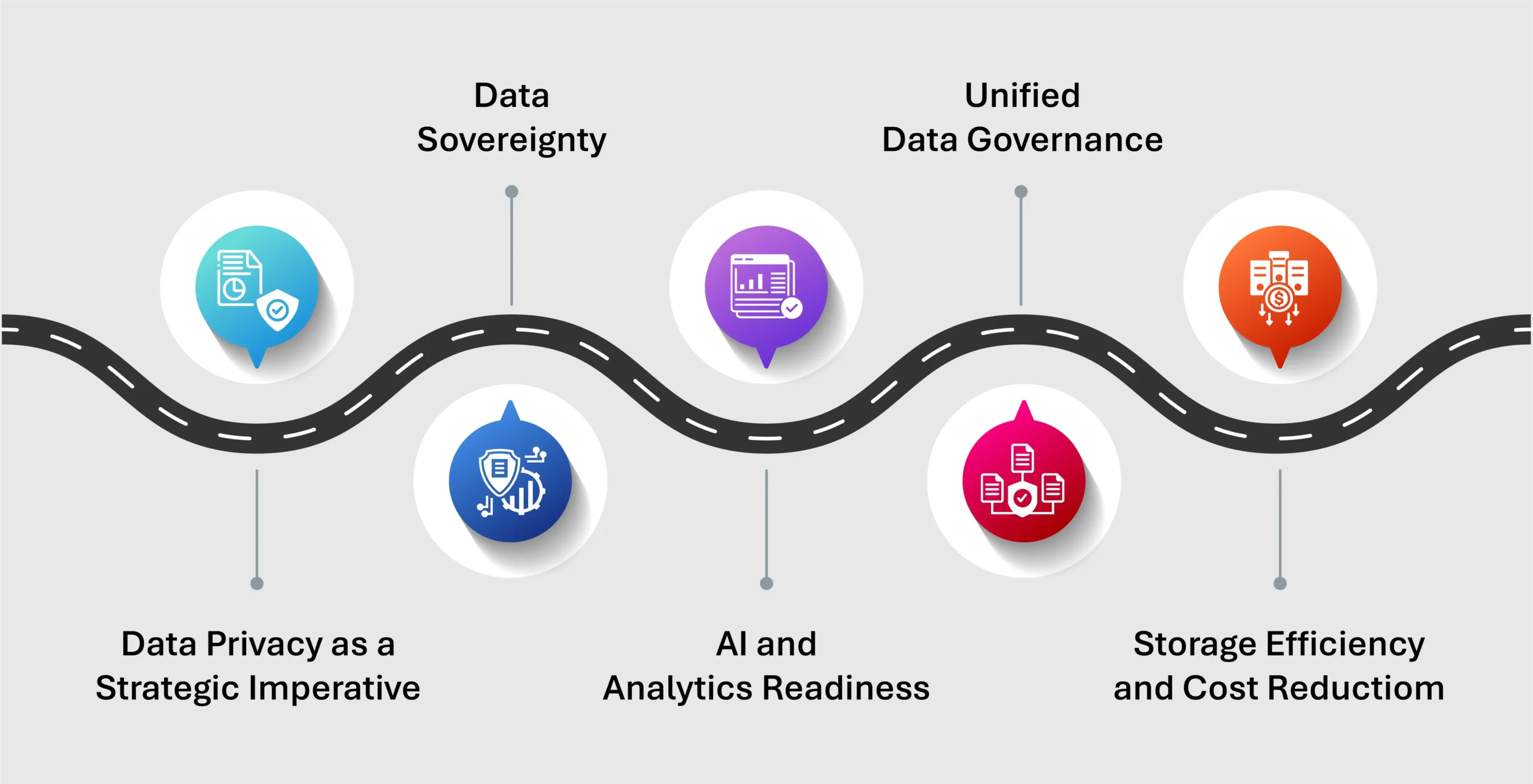Unstructured data—the unruly byproduct of our digital age—has become the paradox of modern enterprises. It’s the proverbial attic, crammed with everything from emails and contracts to IoT logs and social media chatter. The irony? While this data constitutes 80% of all enterprise information, less than 10% of it is actively leveraged, leaving an untapped reservoir of potential that could drive innovation. Even worse, over 30% of this data is redundant, obsolete, or trivial (ROT), silently inflating storage costs and increasing security and compliance risks. It’s not just a missed opportunity—it’s an active liability.
Here’s where the conversation needs a shift: the problem with unstructured data isn’t just its volume or chaos; it’s the mindset with which enterprises approach it. Treating unstructured data as a nuisance rather than a strategic asset is the real issue. The key isn’t merely cleaning it up but unlocking its value through contextualization and collaboration. By aligning the expertise of CIOs with the strategic vision of CDOs, organizations can move from hoarding data to creating actionable insights. It’s not about just managing data better; it’s about transforming unstructured data into a living, breathing ecosystem—one that fuels AI-driven innovation, predictive analytics, and customer experiences that feel almost prescient. The enterprises that crack this code will find themselves not just more efficient but genuinely future-proofed. Let’s dive into the details.
Why Unstructured Data is Everyone’s Problem
Unstructured data doesn’t sit neatly in one department’s lap—it sprawls across an organization, touching every corner but belonging nowhere. That’s the crux of the problem: it’s everyone’s problem, and yet, no one truly owns it. Emerging technologies like AI and machine learning thrive on diverse, high-quality data, but here’s the harsh truth: 85% of AI projects fail to deliver value, often because the data feeding these models is messy, incomplete, or poorly managed. Unstructured data becomes the Achilles’ heel, undermining what should be transformative initiatives.
And then there’s the regulatory side of the equation. With GDPR, HIPAA, and CCPA tightening their grip, mismanaging unstructured data isn’t just a business inefficiency—it’s a compliance time bomb. IBM’s 2024 report paints a stark picture: the average cost of a data breach is now $4.88 million, and breaches involving unstructured data are harder to detect, mitigate, and recover from.
But who should take ownership? Is this an IT challenge or a data strategy issue?
But here’s a perspective to consider: the problem isn’t just about ownership—it’s about alignment. IT can’t solve this alone, and a siloed data strategy won’t cut it. Organizations need a collaborative framework where CIOs and CDOs jointly address the chaos of unstructured data. It’s not about drawing lines around responsibilities; it’s about creating a shared playbook where governance, innovation, and compliance are baked into every decision. The question is how? Let’s explore.
Rethinking Roles: CIOs and CDOs as Co-Stewards of Transformation
Organizations need a fundamental redefinition of how CIOs and CDOs work together. They’re no longer caretakers of their respective domains; they must become co-stewards of organizational transformation, sharing accountability for both the operational foundation and strategic outcomes of data. This shift requires moving beyond transactional interactions toward a shared mission where they jointly design a data-first framework that aligns technology, strategy, and business goals.
This isn’t about dividing responsibilities along traditional lines—it’s about integrating them into a seamless strategy where infrastructure and intelligence constantly feed into and elevate one another. The CIO ensures that data is secure, scalable, and available at the right time, while the CDO ensures that it’s contextualized, governed, and ready to deliver insights. Together, they create a virtuous cycle where the organization can innovate without compromising compliance, optimize costs without sacrificing data quality, and leverage unstructured data as a true competitive advantage.
To make this work, CIOs and CDOs must operate with a unified vision, co-creating shared priorities and metrics. For instance, rather than simply focusing on storage capacity or analytics pipelines in isolation, they need to align on overarching goals like improving time-to-insight, reducing ROT (redundant, obsolete, trivial) data, and enabling real-time decision-making. This unified approach ensures that every decision they make—whether it’s adopting a new AI tool or scaling cloud infrastructure—works toward the same strategic objectives, fostering collaboration that drives both efficiency and innovation.
Building a Collaborative Blueprint for Alignment – A 5-step Roadmap

- Data Privacy as a Strategic Imperative: Embedding Protection into Every Data Layer
Data privacy is no longer just a compliance checkbox; it is a strategic imperative that defines brand trust and competitive edge. CIOs and CDOs must collaborate to embed privacy protection into every layer of the data lifecycle, from collection to utilization. The CIO’s role is to build robust privacy-by-design infrastructure, incorporating features such as automated encryption, data masking, and granular access controls across all systems. At the same time, the CDO develops enterprise-wide privacy frameworks that align with global regulations like GDPR and CCPA, ensuring data practices remain ethical and transparent. By working together, they can establish automated mechanisms to detect privacy risks in real time, mitigating breaches and enhancing customer trust. This collaboration transforms privacy from a regulatory necessity into a differentiator that enhances brand loyalty and secures competitive advantage in an increasingly privacy-conscious world.
- Data Sovereignty: Localized Control in a Global Ecosystem
Data sovereignty is a growing concern as enterprises navigate the complexities of cross-border data flows and region-specific regulations. CIOs and CDOs play critical roles in ensuring that data sovereignty requirements are met without compromising operational efficiency. The CIO is responsible for designing hybrid architectures that localize sensitive data storage in compliance with jurisdictional mandates while enabling global scalability through edge and multi-cloud solutions. Meanwhile, the CDO creates policies and workflows that classify data based on its regulatory exposure, ensuring that only permitted data crosses borders. Together, they enable a federated governance model where data remains compliant with local regulations while still accessible for global analytics and decision-making. This partnership ensures that businesses can operate in diverse markets confidently, turning the challenge of sovereignty into an opportunity to build secure, agile, and regulation-ready operations.
- AI and Analytics Readiness
Advanced AI and analytics initiatives require seamless alignment between infrastructure and data. On the technical front, CIOs need to ensure the deployment of high-performance data pipelines capable of handling large datasets, while CDOs focus on ensuring the cleanliness and contextual relevance of that data. This involves integrating ETL (Extract, Transform, Load) processes with real-time data processing platforms to ensure AI systems are fed with the most accurate and updated information. For example, cloud-based GPU clusters managed by the CIO provide the computational power for AI model training, while the CDO deploys data quality frameworks that leverage tools like Python libraries for data wrangling (e.g., Pandas, Dask) or custom-built APIs to feed these models. Together, they eliminate bottlenecks, enabling faster AI deployments and higher accuracy in analytics.
- Unified Data Governance
Governance isn’t just about setting policies—it’s about building a scalable framework that adapts to the dynamic nature of modern enterprises. CIOs and CDOs working together can design policy-driven data management systems that enforce rules at every stage, from storage to utilization. These systems can leverage metadata-driven automation to identify, tag, and classify unstructured data, ensuring that compliance is not only maintained but also streamlined. Advanced tools like AI-powered data catalogs enable real-time tracking of data lineage and usage, reducing compliance risks and creating audit-ready environments. By eliminating silos and automating workflows, unified governance can save up to 30% of operational time, ensuring that data is not only secure but also prepared for advanced analytics.
- Storage Efficiency and Cost Reduction
Managing unstructured data can be a significant cost driver, but aligning CIO and CDO efforts introduces efficiencies at multiple levels. The CIO can deploy storage optimization techniques like tiered storage or object storage systems to ensure that only high-priority data resides on expensive, high-performance systems. Simultaneously, the CDO can introduce AI-driven ROT detection tools that automatically flag redundant, obsolete, or trivial data for archival or deletion. These technologies reduce storage costs by up to 20% while maintaining a focus on data that generates value. Additionally, implementing containerized microservices architecture allows the CIO to scale resources efficiently, while the CDO uses these same systems to deliver precise insights, ensuring every dollar spent on infrastructure is tied to business outcomes.
Starting Strong: Unified Data as the Cornerstone of Collaboration
The success of a CIO-CDO partnership hinges on one critical factor: achieving a unified, holistic view of the organization’s data ecosystem. This is no small feat, especially given the sprawl of unstructured data across hybrid and multi-cloud environments. Siloed data management systems, designed for isolated functions, often exacerbate the problem by creating fragmented views of the data landscape. Without a cohesive understanding of where data resides, its relevance, or its risks, both CIOs and CDOs are left making decisions in the dark. This lack of integration not only hampers innovation but also exposes enterprises to inefficiencies, compliance challenges, and missed opportunities for data-driven growth.
Zubin steps in to address this challenge with a forward-thinking, unified approach to data management. It’s built to bring everything together—advanced metadata intelligence, content analytics, dynamic data pipelines, federated governance, role-based access control, and a self-service unstructured data management framework—all working seamlessly to create a single source of truth. This means CIOs can focus on scalability and security, while CDOs can dive into actionable insights and ensure compliance without battling silos or inefficiencies.
Whether it’s managing risk, strengthening data security posture, ensuring privacy compliance, meeting data residency and sovereignty requirements, optimizing infrastructure, or building a sustainable data lifecycle, Zubin creates the clarity and alignment needed for collaborative leadership. By making data accessible, contextualized, and ethically usable, it doesn’t just solve a technical challenge—it sets the stage for real innovation and trust. It helps organizations move faster, work smarter, and build a resilient data strategy that adapts to whatever comes next in this complex digital world. To know more about Zubin and try it first hand, visit – https://www.datadynamicsinc.com/
Sources:
- While unstructured data constitutes 80% of all enterprise information, less than 10% of it is actively leveraged, leaving an untapped reservoir of potential that could drive innovation.
- Over 30% of this unstructured data is redundant, obsolete, or trivial (ROT), silently inflating storage costs and increasing security and compliance risks.
- 85% of AI projects fail to deliver value, often because the data feeding these models is messy, incomplete, or poorly managed.
- The average cost of a data breach is now $4.88 million.






